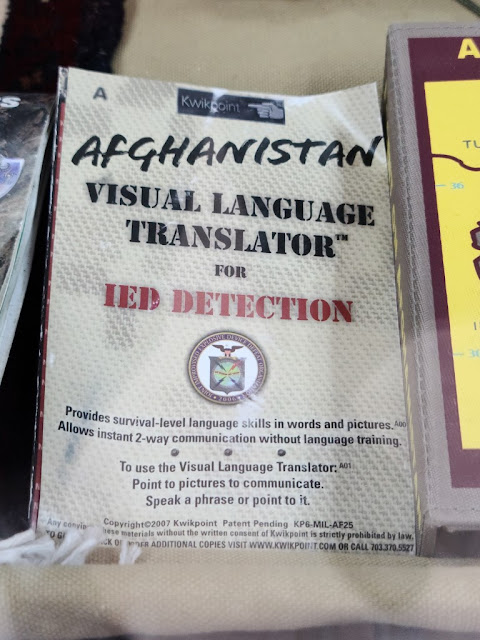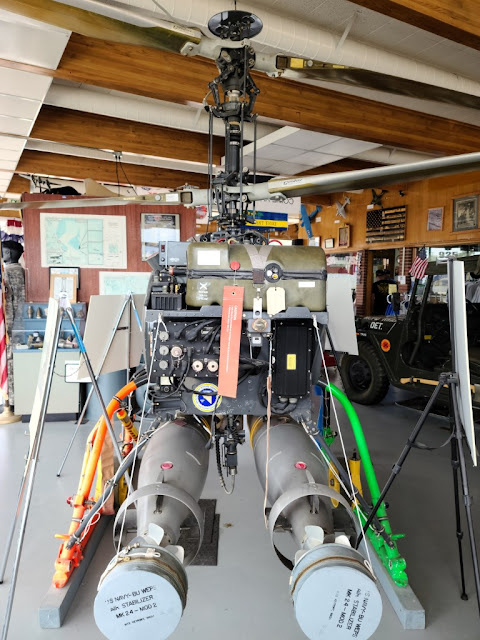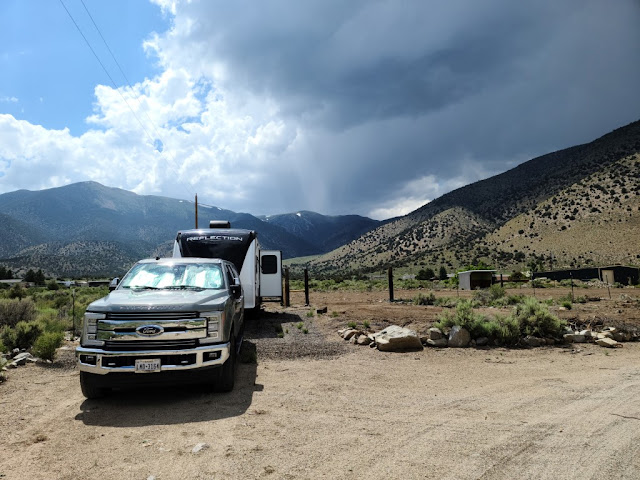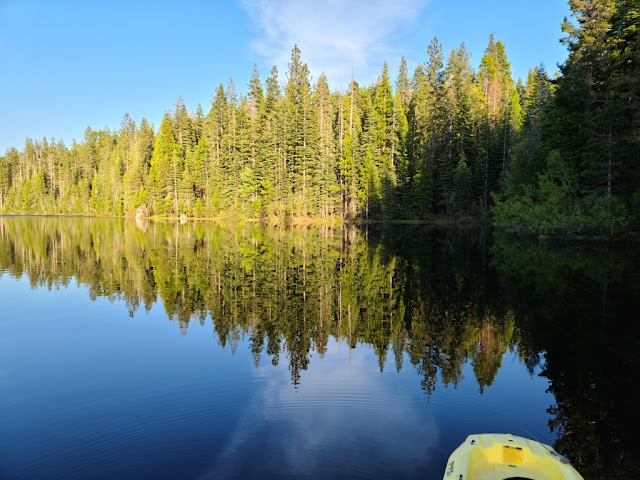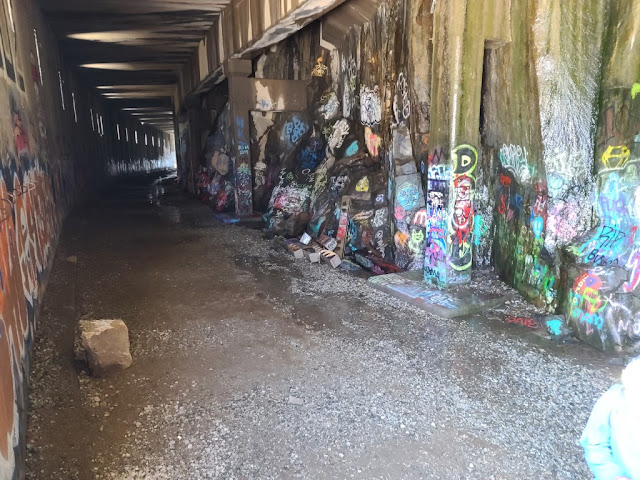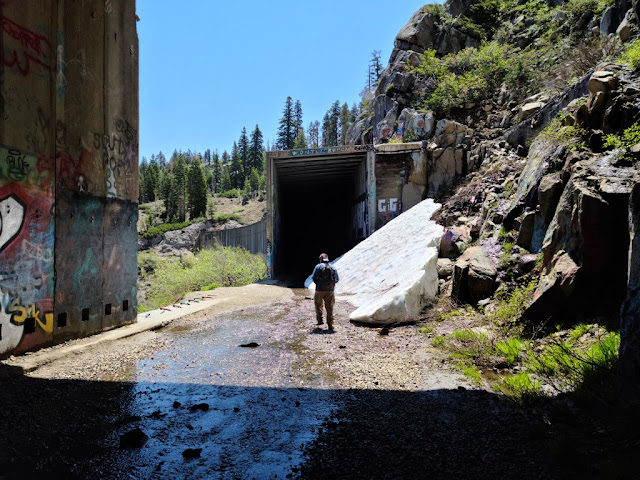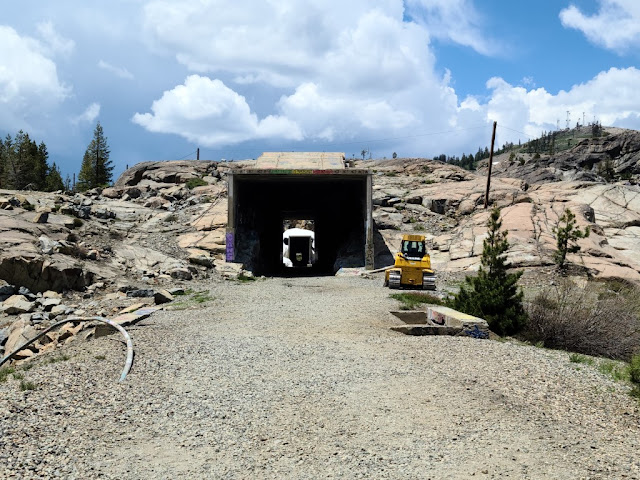After a whirlwind trip to Las Vegas with a side trip to California (without the RV), it was time to start our summer travels. We were getting tired of the desert and ready for some cooler temperatures and to see trees. Our first stop for a night was dry camping at Tonopah Dispersed Camping on BLM (Bureau of Land Management) land in Nevada. We've stayed at this site before so we knew what to expect upon arrival.
Along the drive the next day as we headed north we had nice views of the eastern Sierra mountains with snow still visible.
We spent the next night at the Elks Lodge in Hawthorne, NV.



This lodge has parking for a few RV's in the back parking lot with electricity hookups.
We got parked and set up and then went for a walk to check out town. The nearby Hawthorne Army Depot is the primary economic base of the town.
Hawthorne Army Depot stores reserve ammunitions
to be used after the first 30 days of a major conflict. It is only
partially staffed during peacetime, but provision has been made to
rapidly expand staffing as necessary. An independent contractor runs the
depot under an agreement with the government.
 |
Photo courtesy of Google Images
|
There was not much in town but we came across this military museum. The price was right, free, so we went inside to look around.
 |
Naval Undersea Warfare Center Detachment
Hawthorne, Nevada |
 |
A Gyrodyne QH-50C Drone Anti-Submarine Helicopter (DASH)
Destroyer on an Anti-Submarine Warfare (ASW) Mission with two Mk 44 Mod 0 honing torpedoes. |
Placed in service in 1957, the Mk 44 Mod 0 was an improved, lightweight ASW torpedo. An electric motor and a sea-water-activated battery provided the power source for this weapon. The Mk44 was deployed on US destroyers and aircraft for about 10 years and then was replaced by the Mk 46 torpedo.
 |
| WWII Bombs 250 & 500 lb with inert fuse |
 |
MK 17 ASROC Nuclear Depth Charge (top)
Anti-Submarine Missile and Balistic Missile (1960's) |
The museum looked small from the outside but as we walked around we kept finding more and more side rooms with more display items. I turned one corner and there was a giant tank in the museum!
 |
Abbot FV433 Self-Propelled Gun (SPG)
Retired Jan 11, 1994 from Regiment Royal Artillery in England.
Purchased by a farmer in England and shipped and restored in North Texas.
105mm Gun fires US M1 Projectile up to 9.3 miles.
12-rounds per minute rate of fire with 360 degree turret traverse.
|
 |
Funny looking phone with a rotary dial
|
 |
History of Naval Mine Warfare
Mines and Mine Countermeasures
|
 |
Cluster Bomb Unit-24 (CBU-24C/D)
Unguided, Aircraft Delivered, Anti-Personal/Anti_Material (APAM)
Payload of 665 BLU-26 "Baseball Sized" submunitions.
Over 2 million CBU-24's dropped over Vietnam, Laos, and Cambodia during the Vietnam War (1964-1973)
|
 |
In Laos
|
 |
Undersea Mine MK16
|
This type of mine was deployed from surface ships and submarines. The
larger round section of the mine contains 600 lbs of cast TNT. When the
enemy ship moves near the mine, the smaller float makes contact and sets
off the detonator. The main explosive device lifts the ship out of the
water and breaks its keel. Well, that was an interesting museum. Glad we stopped by.
Our next stop was a Harvest Host property,
Great
Basin Alpaca farm in Smith Valley, Nevada. We were their first guests under the Harvest Host program so they were excited to have us and the girls were anxious to meet us.
 |
The greeting crew
|
They told us where to park on their property so we got parked and set up.
 |
Another greeter, Coco, the sheep
|
We met
their 4 female alpacas (2 were pregnant and one was only 6 months old). We also met their sheep, Coco, 2 dogs and 2
goats. They also had 4 male alpacas
which were in a separate pen.
 |
Some of the alpacas in their backyard
|
Al offered to help the Dad put up a wire fence while I walked with Mom and the girls to
see the chickens and the little store where they sell alpaca items.  |
The male alpacas
|
 |
We picked cherries from their trees
|
It was so peaceful and we got a great night's rest. The next morning before we left we worked more on their fence. This will be a new pen for the alpacas.
Then we bought some fresh eggs from their chickens. The girls were looking for eggs in the chicken coop.
 |
Our hosts have a beautiful property with nice mountains
|
Our hosts could not have been more accommodating and we enjoyed our time at their little piece of heaven. We left Smith Valley, Nevada and drove in to California and over the mountains and then north along Lake Tahoe and then west to Emigrant Gap, California to the Snowflower Thousand Trails Campground.
We found an open campsite and Al squeezed us in to it. Ahhhh.....to be back in the woods again with nice tall trees all around!
After we got set up, we went for a walk. The bugs were bothering Al so he went back to the RV while I continued to walk. I walked by a 5th wheel and noticed their kayaks and a little sign that said their names. I called out to them and sure enough it was our friend Bill's cousins, John and Tina. We met them at Snow Canyon State Park back in 2018 and then met up at the Albuquerque Balloon Fiesta last year. They also travel full-time in their RV so we have that in common. So funny who you run in to.
The lake at the campground was beautiful.
How cool that we got to see Snow flowers while staying at Snowflower Campground.
 |
| Snowflowers |
The next day we went for a little hike from the campground with John & Tina and their friends.
 |
Nancy and Tina
|
While out running errands one day, we found a place selling diesel for $3.55/gallon. What a deal!
Several people we spoke to recommended that we see the old Donner Pass Summit Tunnels while in the area.
The now-abandoned tunnels were built for the transcontinental railroad on the route where the first wagon train entered California. A series of now-abandoned tunnels were completed in August 1867, and the first train passed through it in 1868.
The tunnels at Donner Pass were constructed by Chinese laborers and took more than 15 months of hard work to finish. A dozen tunnels were some of the most treacherous parts of the transcontinental railroad, linking the rail networks of Omaha, Nebraska, to the West Coast at Oakland. They were constructed through the use of hand drilling, black powder, and nitroglycerin (leading to an untold number of worker deaths). Extensive snowsheds were built between the tunnels. These snowsheds can still be seen from the nearby interstate.
It was recommended to bring flashlights and to dress warm for this hike.
The tunnels are covered with graffiti.
There were sections of tunnels, one after the other. Between some of the tunnels there was still snow hence the need for the tunnels to run the trains!
We were lucky that the day we visited the tunnels it was not that busy with other tourists.

 |
Even the snow had graffiti
|
 |
| We were really glad we brought our flashlights. Some of the tunnels were very dark! |
We walked through about five long tunnels and got to a big opening and
decided to turn around and hiked back the way we came. We hiked about 5
miles total.
We stopped and ate a snack overlooking Donner Lake.
 |
Donner Lake with China Cove Beach visible
|
 |
The tunnel and snow sheds are visible hugging the mountain
|
Surprisingly we didn't find one can of spray paint during our hike!
When we got back to the campground, there was some hail left over from a storm. We missed the whole storm by being in the tunnels.
 |
Hail in the campground
|
One day we went to historic downtown Truckee, California for lunch and to walk around.
Next we went to visit the shores of Donner Lake.
 |
Donner Lake
|
 |
Donner Lake
The Historic Railroad Tunnels are visible from the lake (on the right side just below the snow).
|
Here is the area covered in this blog entry.
Next we'll spend the July 4th week at a campground in South Lake Tahoe.
Thanks for following along.......








